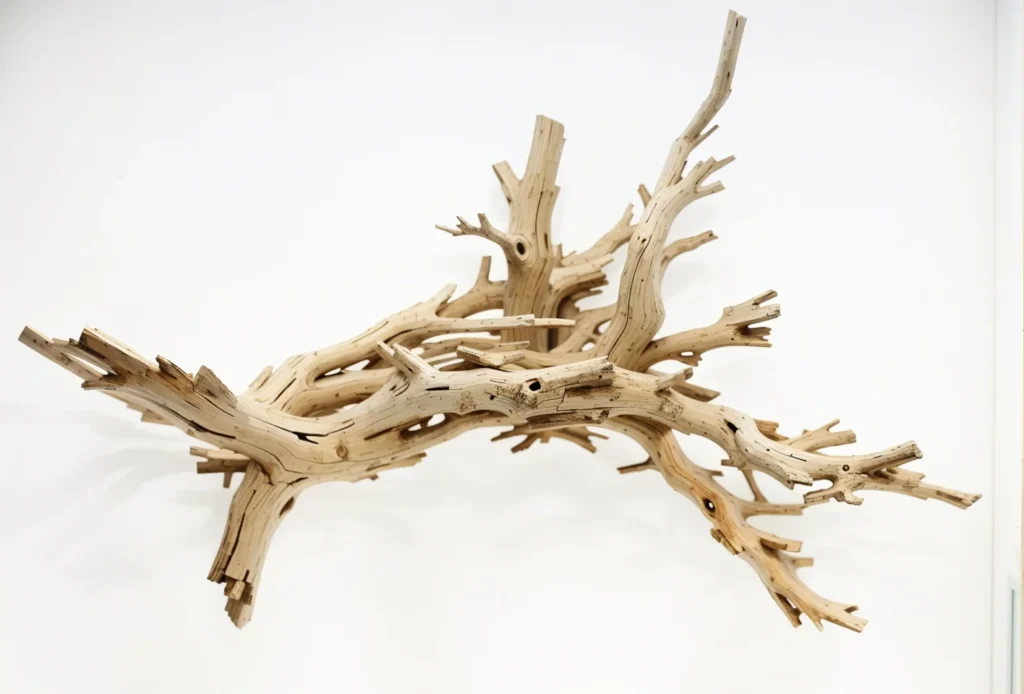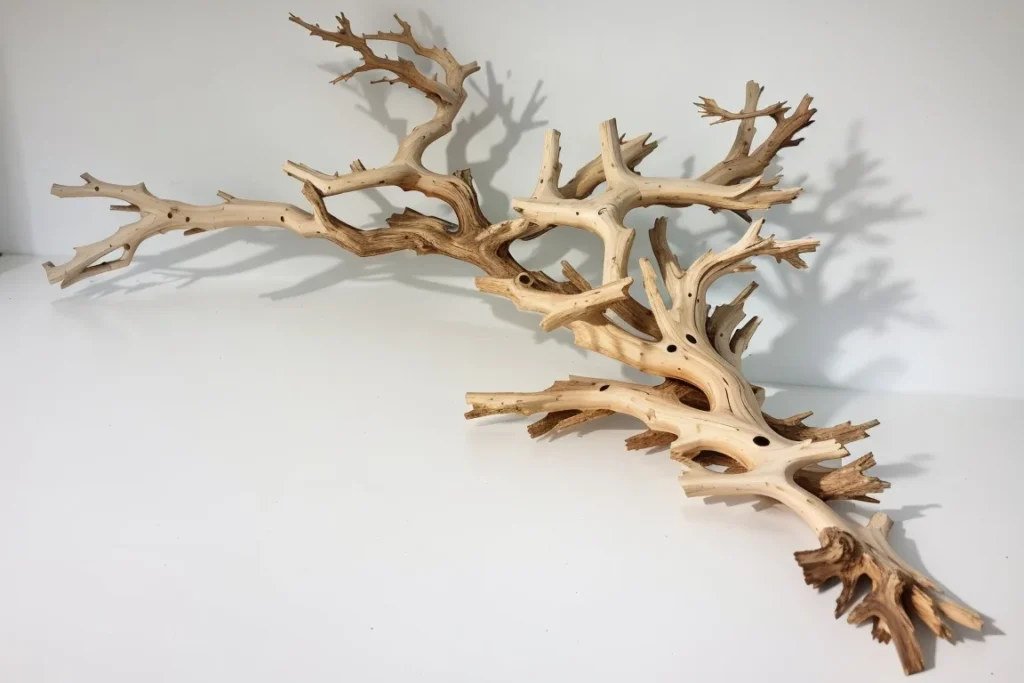Ghostwood is a unique type of driftwood that is pale, often white or light tan. It gets its name from its ghostly, paranormal-like appearance. Ghostwood is popular in aquariums, terrariums, and other home decor uses due to its aesthetic look and properties that make it suitable for these applications.
Ghostwood is valued in the aquarium hobby for not altering water chemistry drastically while offering driftwood’s benefits. It provides shelter and food for tank inhabitants as it slowly decays. Ghostwood’s minimal tannin release prevents it from staining water or dramatically impacting pH.

This wood is also prized in terrariums as it integrates seamlessly with plants and decor. Its weathered look gives an aged, natural appearance. Ghostwood is lightweight compared to other hardwoods, making it easy to incorporate in terrarium designs.
Understanding what ghostwood is and where it comes from helps aquarists and terrarium hobbyists determine if it fits their needs. Examining its properties and how to source ethical, non-toxic pieces is key.
What Kind of Wood is Ghostwood?
Ghostwood comes from trees in the Juniperus genus, most commonly the Juniperus Californica species native to western North America. It is a type of softwood coming from coniferous trees.
The Juniperus Californica tree, also known as the California Juniper, grows at high altitudes ranging from 1500 – 3000 meters. It thrives in rocky soils and is drought tolerant. These hardy trees can live up to 1000 years. Their natural habitat spans southwestern Oregon through California.
While a softwood, ghostwood is generally harder and more rigid than other driftwood types like grapewood or mopani. It is durable and will not quickly decompose. Its density causes it to sink in water unlike more porous soft driftwoods.
Ghostwood has a fibrous grain and may have small holes or indentations on the surface. Older pieces tend to be paler than freshly harvested ones. The wood can range from creamy white to light beige or tan.
Why is it Called Ghostwood?
Ghostwood gets its name from its lighter color and weathered appearance, which gives it a ghostly, otherworldly look. When submerged in water or misted in a terrarium, it almost glows, enhancing the paranormal effect.
The pale hue results from processing and preparing the wood for sale. Suppliers weather, bleach, and sometimes sandblast ghostwood to create the signature white coloration. This gives each piece a clean, bright appearance.

Untreated ghostwood has a darker, more natural wood tone. But the weathered, ghostly esthetic is part of Ghostwood’s appeal. Its unique look made it popular for fashioning bonsai trees and aquarium sculptures.
The name “ghostwood” may also relate to dead juniper trees that remain standing due to the hardy nature of the wood. These dried out husks earning them a ghostly reputation before being harvested.
Is Ghostwood Good for Aquariums?
Yes, ghostwood is an excellent addition to freshwater and saltwater aquariums. Its durability and minimal impact on water parameters make it suitable for most setups.
Ghostwood provides multiple benefits for aquatic life:
- Food Source – As it slowly decays, ghostwood releases beneficial tannins, acids, and nutrients into the water that fish, invertebrates, and plants can utilize.
- Shelter – Driftwood provides hiding spots for shy species and surfaces for aquatic life to graze and lay eggs on. The crevices and holes become microhabitats.
- Environmental Enrichment – Driftwood diversifies the environment, stimulating natural behaviors in tank inhabitants. Fish and invertebrates interact with the wood.
- Natural Look – Ghostwood introduces a sense of nature, replicating the look of submerged wood in rivers and lakes.
Ghostwood does not drastically impact pH or water chemistry. Its mild tannin release avoids staining the water brown like other driftwoods can. This makes ghostwood suitable for a wide range of aquariums.
Is Ghostwood Safe for Aquariums?
Ghostwood is non-toxic and safe for aquarium life as long as it’s from a reputable source. You want wood that is completely natural with no chemical treatments.
Some things to look out for when sourcing ghostwood:
- Pesticides – Some ghostwood is harvested from tree farms and may have been chemically treated. Pesticide residues could leach into the tank water, harming inhabitants.
- Bleaching – While bleaching sanitizes the wood, residual chemicals left behind may be problematic. Opt for wood that was air or sun bleached instead.
- Dyes – Some ghostwood is artificially dyed or whitewashed. Choose wood with its natural pale color instead.
- Varnish – Never use ghostwood treated with varnish, paint, or other sealants in an aquarium. Toxic compounds will leach into the water.
Asking questions to verify if the ghostwood was responsibly harvested is key. An established aquatic wood supplier who specializes in driftwood for pets is ideal. Properly prepared ghostwood is inert and safe.
Does Ghostwood Leach Tannins?
Ghostwood releases some tannins into the water, but not at levels that significantly impact aquarium chemistry or clarity. Its tannin content is lower than other driftwood types.
Tannins create the yellowish tea-like water often seen in blackwater aquariums. While high concentrations are unsuitable for fish, low levels benefit the tank by:
- Creating a natural environment – Many species originate from tannin-stained waters.
- Lowering pH – Tannins release organic acids that gently soften water. This helps fish that prefer low pH.
- Antibacterial & antifungal properties – Tannins prevent fungal and bacterial outbreaks.
Unless you are aiming for a blackwater biotope, the small amount of tannins ghostwood releases won’t overload the water. Larger pieces or adding multiple driftwoods may release more tannins.
Performing water changes and using chemical filtration like activated carbon can remove excess tannins if needed. But for most tanks, the tannin release from ghostwood is a non-issue.
Ghostwood Price and Where to Buy
Ghostwood is moderately priced compared to other aquarium driftwoods. Price depends on size, shape, and quality level:
- Small pieces under 8 inches cost $5 – $15.
- Medium pieces 8-12 inches run from $15 – $40.
- Large statement pieces 12+ inches can cost $50 – $100.
- Detailed sculptures and multi-piece layouts are most expensive.
Ghostwood is available at specialty aquarium stores and online retailers like:
- Aqua Forest Aquarium (San Francisco)
- Imperial Tropicals
- Driftwood Center
- Bloomsandbranches.com
- Driftwoodusa.com
Check reviews and shop with reputable sellers that specialize in the pet trade. Beware of non-aquarium ghostwood that may be treated or toxic.
Examine pieces carefully for damage, rot, or signs of pests. Properly cured wood will be rigid, with no oozing sap or foul odors. An established, clean cut area confirms the wood has been aged and prepared for submersion.
What is Ghostwood Driftwood?
Ghostwood driftwood refers to weathered ghostwood sculpted naturally by water currents and elements. The wood shapes from exposure to flowing rivers, lakes, and ocean tides over time.
Compared to commercially harvested ghostwood, naturally formed ghostwood driftwood has:
- More organic, irregular shapes instead of cut blocks.
- Smoother surfaces worn down by tumbling in waves and rivers.
- Lighter color from extended sun exposure while floating or on shorelines.
- Accumulated algae, lichens, and microorganisms that provide natural aquarium cycling.
Finding authentic ghostwood driftwood is rare since most available pieces are commercially harvested then sold as plain ghostwood. Any naturally shaped pieces command a higher price.
What is Considered Driftwood?
Driftwood refers to any pieces of wood washed ashore by waterways. Most driftwood originates from trees that fell or washed into rivers where water currents carry them downstream until they eventually end up deposited along ocean coastlines.
Common examples of driftwood species include:
- Oaks
- Pines
- Cedars
- Redwoods
- Cypress
- Maple
- Birch
Wood processed for commercial sale is generally no longer considered true driftwood. However, ghostwood is an exception since its pale appearance comes from post-harvest treatment.
Driftwood Description and the Driftwood Rule
Some regulations are surrounding collecting and selling driftwood in certain areas:
- Public lands often prohibit removing natural resources like driftwood without permits.
- Coastlines may be classified as protected areas where driftwood removal is illegal.
- Some commercial drift wood harvesting requires permits and licenses.
These laws are called the “driftwood rule” and aim to prevent overharvesting of shoreline wood before it plays its natural ecological role. Decaying driftwood is crucial for stabilizing coastlines and providing marine microhabitat.
When sourcing ghostwood, verifying it comes from legal and sustainable harvesting practices is important. Choosing sellers specialized in properly collected and cured decorative wood helps guarantee its origins.
Types of Driftwood and Their Uses
There are many varieties of driftwood available, each with their distinguishing features and uses:
| Type of Driftwood | Good for Aquariums? | Good for Terrariums? | Leaches Tannins? |
| Ghostwood | Yes | Yes | Mildly |
| Mopani Wood | Yes | Yes | Yes |
| Malaysian Driftwood | Yes | Yes | Yes |
| Spider Wood | No | Yes | No |
| Manzanita Wood | Yes | Yes | Yes |
| Grapewood | Yes | No | No |
Ghostwood – As covered in this guide, ghostwood is suitable for most aquarium and terrarium uses.
Mopani Wood – A dense African hardwood that releases heavy tannins. Best for blackwater aquariums or large tanks to dilute the effects. Avoid in terrariums where tannins can overwhelm plants.
Malaysian Driftwood – Tropical Asian driftwood ideal for planted aquariums. Releases lots of tannins to lower pH. Prone to rotting in humid terrariums.
Spider Wood – Unique branching formations but fragile and not water-resistant. Better for terrestrial terrariums than aquariums.
Manzanita Wood – Hard North American wood with twisting shapes. Use in aquariums and drier terrariums. Leaches some tannins.
Grapewood – Extremely lightweight and porous but structurally weak. Not suitable for aquarium use but okay in dry terrariums.
Conclusion
Ghostwood is a unique type of wood perfect for infusing aquariums and terrariums with a mysterious, weathered aesthetic. Its suitability for underwater use, minimal impact on water parameters, and sparse tannin leaching makes ghostwood a versatile option.
With its pale white coloring and natural texture, ghostwood introduces an intriguing paranormal feel. This driftwood allows hobbyists to get creative with aquascapes and terrarium layouts. Sourcing ethically harvested and properly cured ghostwood ensures it integrates safely.
From tiny nano tanks to paludarium centerpieces, ghostwood will level up any aquatic or riparium project. Exploring different arrangements and combining ghostwood with complementary materials like rocks or mosses unlocks its full potential. Let ghostwood bring an eerie yet fascinating vibe to your next aquarium or terrarium design!